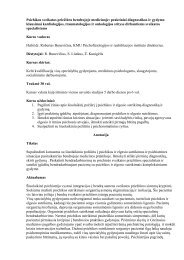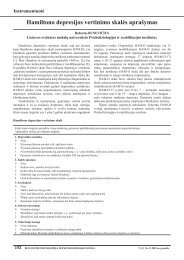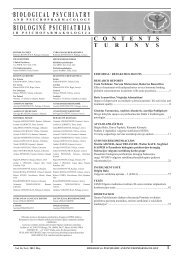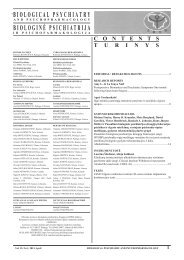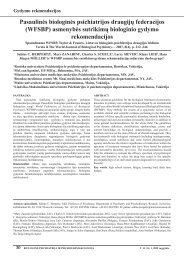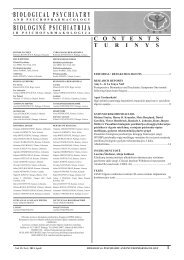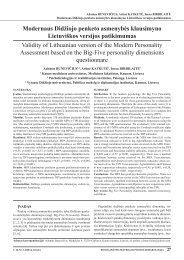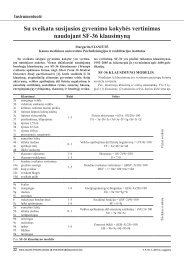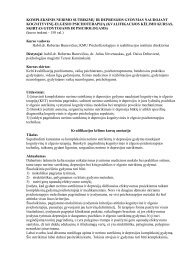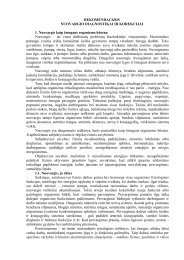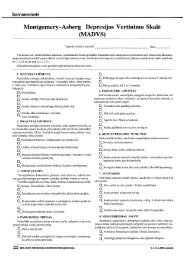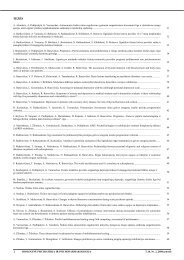biologinÄ psichiatrija - Psichofiziologijos ir reabilitacijos institutas ...
biologinÄ psichiatrija - Psichofiziologijos ir reabilitacijos institutas ...
biologinÄ psichiatrija - Psichofiziologijos ir reabilitacijos institutas ...
- No tags were found...
Create successful ePaper yourself
Turn your PDF publications into a flip-book with our unique Google optimized e-Paper software.
V<strong>ir</strong>ginija Adomaitienė, Darius Leskauskas, Gediminas KuncaDepression symptoms: significance of the c<strong>ir</strong>cadian rhythms. Review of literatureIntroductionThe c<strong>ir</strong>cadian rhythms act like a multifunctional timer toadjust the homeostatic brain system, including sleep and alertstates, locomotor activity, to approximately 24 hour cycle andallow organisms to adapt to env<strong>ir</strong>onmental changes [1].The endogenous c<strong>ir</strong>cadian rhythm comes in cycles ofroughly 24–25 hours, but is unadulterated only when a personis completely isolated from the outside influences (e.g.,in a windowless basement, dark cave, etc.). External zeitgebers(incoming signals) synchronize the biological clock toprecise 24–hour cycles. It takes several days to “reset” thebiological clock, e.g., after a long journey from east to west(jet lag). The mechanism by which this cycle activates subsequentneuronal actions (membrane potentials) is still unclear.The main external zeitgeber for 24–hour synchronizationof the sleep–wake cycle is bright light (photic input). Lightstimuli are d<strong>ir</strong>ectly sensed by a small, melanopsin-containingfraction of retinal ganglion cells and conducted to the suprachiasmaticnucleus (SCN) via the retinohypothalamic tract.The coupled cells of the SCN generate c<strong>ir</strong>cadian rhythms ofhormone secretion, core temperature, and sleep–wake cyclesby various effector systems of the CNS. The zeitgeber slowsor accelerates the rhythm, depending on which phase it is in.Signals from the zeitgeber also reaches the epiphysis (pinealbody, pineal gland) where it inhibits the secretion of melatoninwhich is high at night. Since it exerts its effects mainly onthe SCN, administration of melatonin before ret<strong>ir</strong>ing at nightcan greatly reduce the time requ<strong>ir</strong>ed to “reset” the biologicalclock. The main reason is that it temporarily “deactivates” theSCN (via MT2 receptors), thereby excluding most nocturnalneuronal input (except light stimuli) [2].Molecular clock„Inner clock“The primary molecular clock is located in the suprachiasmaticnucleus (SCN) in the hypothalamus, and consists ofa transcriptional feedback loop which cycles over the courseof ~24 hr in the absence of env<strong>ir</strong>onmental input. The majortranscriptional activator consists of a dimer between the c<strong>ir</strong>cadianlocomotor output cycles kaput protein (CLOCK) andbrain and muscle ARNT-like protein 1 (BMAL1, also knownas ARNTL or MOP3). This complex binds to E–box sequencesin the promoters of many genes including the Period (Per)and Cryptochrome (Cry) genes. The PER and CRY proteinsare translated in the cytoplasm, and are phosphorylated bycasein kinase 1 (CK1) ε and δ and glycogen synthase kinase3β (GSK3β), leading to changes in the<strong>ir</strong> stability, associationand nuclear entry. Upon entering the nucleus, theycan repress the actions of CLOCK/BMAL1, thus creatinga negative feedback loop. In addition, there is an adjoiningloop in which CLOCK/BMAL1 activates the transcription ofRev–erbα and Rorα. Once translated, these proteins can bindto the promoter of the Bmal1 gene and both positively andnegatively affect its transcription. Selectively in forebrainregions, neuronal PAS domain protein 2 (NPAS2), a proteinvery similar to CLOCK, can bind BMAL1 and induce Per andCry gene expression. NPAS2 may also function in the placeof CLOCK in the SCN if the CLOCK protein is geneticallydefective. Though the central c<strong>ir</strong>cadian pacemaker is locatedin the SCN, all of these genes are expressed throughout thebrain and in other organs where they function as peripheralclocks that respond to non–photic stimuli, and likely also inother processes unrelated to c<strong>ir</strong>cadian rhythms [3, 4].Influence of the molecular clock on mood–relatedneurotransmitter systemsThe biological factors that underlie the relationship betweenc<strong>ir</strong>cadian rhythms and mood disorders are still unknown, butprobably could be related with the influence of the molecularclock on certain neurotransmitters and the<strong>ir</strong> receptors. Indeedsome of the major neurotransmitters that have been implicatedin mood regulation, including serotonin, norepinephrine anddopamine, have a c<strong>ir</strong>cadian rhythm in the<strong>ir</strong> levels, release, andsynthesisrelated enzymes. There are also c<strong>ir</strong>cadian rhythms inthe expression and activity of several of the receptors that bindthese neurotransmitters, suggesting that these ent<strong>ir</strong>e c<strong>ir</strong>cuits areunder c<strong>ir</strong>cadian control. It seems likely that disruptions in thenormal rhythms in these c<strong>ir</strong>cuits (either continuous or abrupt)could have major effects on mood and motivational states.How these c<strong>ir</strong>cuits are controlled in a c<strong>ir</strong>cadian manner is stilluncertain. Some of this modulation seems to occur throughconnections between the SCN and other brain regions. For example,an ind<strong>ir</strong>ect projection from the SCN to the locus coeruleusappears to regulate the c<strong>ir</strong>cadian rhythm in noradrenergicneuronal activity. Furthermore, c<strong>ir</strong>cadian gene expression outsideof the SCN, in these specific regions, may contribute tothe<strong>ir</strong> rhythmic activity. C<strong>ir</strong>cadian activity rhythms in rodentscan be entrained to daytime methamphetamine injections, evenin SCN lesioned animals. This treatment shifts the expressionof the period genes in striatal regions typically associated withmovement control in a manner that matches the shift in activityrhythms. This same shift in period gene expression does notoccur in the SCN with methamphetamine treatment, thus thereis a disconnect between the SCN, molecular rhythms in thestriatum and locomotor activity rhythms. This suggests thatthe period gene expression and rhythms in striatal regions isimportant in producing rhythms in locomotor activity. Therefore,the c<strong>ir</strong>cadian genes both in the SCN and in these specificc<strong>ir</strong>cuits may be involved in regulating this rhythmic activityin neurotransmission. Future studies are needed to determineexactly how these rhythms in dopamine, serotonin and otherneurotransmitters are involved in mood regulation [3].Synthesis of melatoninMelatonin is synthesized from tryptophan in a series offour enzymatic steps. F<strong>ir</strong>st, tryptophan hydroxylase (TPH)converts tryptophan to 5–hydroxytryptophan, which is thenconverted to 5–hydroxytryptamine (serotonin) by aromaticamino acid decarboxylase. Serotonin is then converted toN–acetylserotonin by arylalkylamine N–acetyltransferase.N–acetylserotonin is converted to melatonin (N–acetyl–5–methoxytryptamine) by hydroxyindole–O–methyltransferase.The enzyme activity and mRNA encoding TPH and AANATdisplay c<strong>ir</strong>cadian rhythms of expression, with highest levelsoccurring at night. Melatonin is a highly lipophilic molecule,and presumably diffuses out of the cells as soon as it is synthesized,into the neighboring cells and tissues [5].T. 10, Nr. 1, 2008 m. b<strong>ir</strong>želisBiologinė <strong>psichiatrija</strong> <strong>ir</strong> psichofarmakologija37



